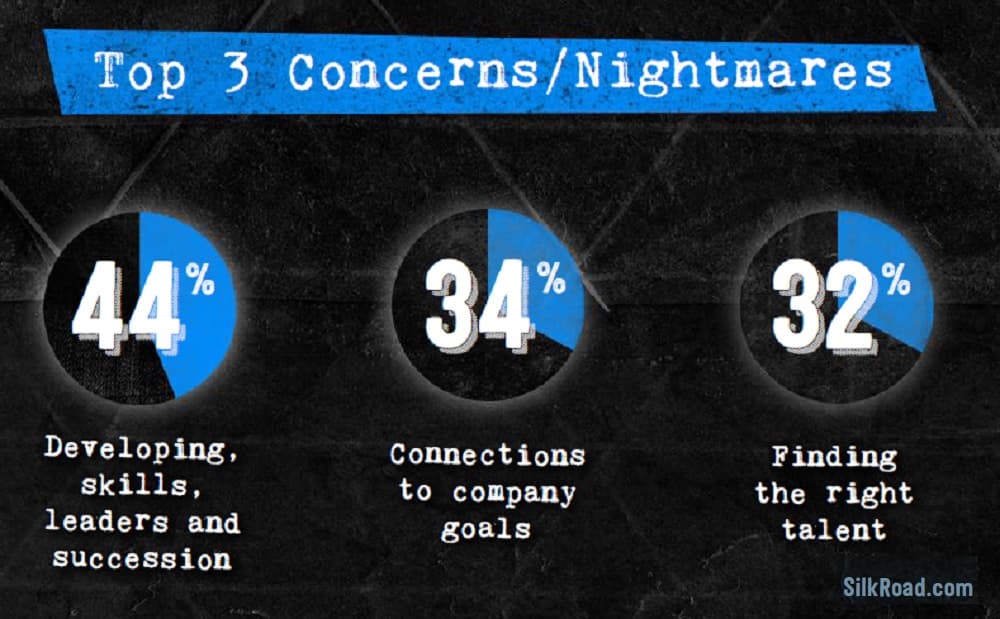From concerns about how to motivate employees to meet company goals to worries over how to gain a “big picture” of company talent through data and analytics, a host of work-related issues haunted HR professionals in 2016, according to SilkRoad’s latest “What Keeps HR Up At Night?” report.
Each year, SilkRoad aims to uncover the top nightmares of HR pros across many HR functions, including talent management and retention, by probing their perspectives, challenges and concerns. In 2016, the questions that typically robbed their sleep were:
- How can I connect with and motivate our employees more effectively?
- Why isn’t technology helping me do my job better?
- What programs and experiences should I be providing our employees to better engage them?
Disconnects
The report revealed a number of shocking disconnects. For example, though the respondents recognized the opportunity to develop and prepare for employee transitions such as promotions, mergers, and acquisitions and relocations, almost half (48%) had no formal process for managing transitions.
While 71% of the HR pros rated assessing experience at each career stage as very important, 59% lacked a formal process to do just that.
Even though nearly 9 out of 10 (86%) of the respondents rated connecting employees back to company goals as either very important or important, only half (56%) had a formal process that links experiences to goals.
Agile management
In compiling the latest report, SilkRoad surveyed 728 HR pros, more than half of whom (56%) have more than a decade of experience in the industry. What became abundantly clear is that while employees crave a clear understanding of how they can contribute to their company’s business goals, many HR pros need better tools to aid managers to offer such direction.
By and large, these concerns are the result of deeply embedded business processes that have frustrated HR pros for years. To break free, organizations need a fresh approach, and agile performance management fits the bill.
Unlike traditional performance management practices that dwell on measuring the past, agile performance management focuses on improving the future through ongoing and flexible conversations between employees and their managers with an emphasis on current projects and upcoming needs.
With agile performance management, employees work with their manager to establish a small number of near-term expectations. They meet regularly to discuss and, if needed, adjust the expectations. This dialogue empowers the employee to take action when they spot a need, run into an obstacle or need assistance. An instant feedback process encourages the employee and manager to immediately adjust course when needed, without waiting for an annual performance discussion.
Top technology woes
HR technology yielded a mixed bag of sentiments from the surveyed HR pros, 39% of whom said their top technology concern was having disconnected data stored in separate systems. 37% said they worried about not having the data and analytics capabilities they need to gain a real-time “big picture” of their company’s talent, and 35% continue to manually compile data for reports and key metrics.
Although many of our respondents said technology has allowed them to automate their HR functions, very few said they have been able to leverage the technology to engage their employees around strategic business goals and ultimately transform their business.
Technology gap
In other words, a wide gap exists between what HR pros have achieved with technology and what they need from technology to help them succeed in the eyes of management. To close the gap, companies must find a new way to engage all stakeholders, tear down siloed systems and applications, and most importantly, connect employees directly with positive business outcomes. To make all this happen, companies need to raise their traditional talent management and employee engagement practices to a new standard –“talent activation.”
Talent activation
Talent activation engages and inspires talent for improved business outcomes through a heightened “employee first” focus and by delivering innovative technology that answers the demands of today’s highly mobile, widely social and information-hungry workforce. Talent activation helps companies focus on — and leverage — each experience throughout the entire employee lifecycle instead of the disparate and disconnected employee activities that hallmark traditional talent management practices.
By placing the employee at the forefront and creating positive experiences with the business, talent activation enables companies to engage employees at the most opportune times and empower faster, more productive, motivated and inspired business results.
The world of work is changing, and no amount of warm milk is going to provide you with a good night’s sleep if you continue to hold on to traditional approaches to talent management and retention. In other words, talent management is no longer enough, and agile performance management and talent activation are now what you need to meet these new demands. Start the transition soon and you’ll get the rest you deserve before you know it.
